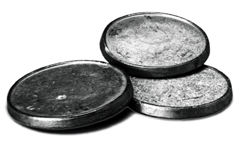 This is a low melting point solder, nearly identical to what is commonly called Wood’s Metal. An alloy of bismuth, tin, lead, and cadmium, it is an eutectic alloy with a sharply defined melting point of 343.16 K (70
°C). Ostalloy® 158 has proven itself in production processes — there is no equal to be found to its special advantages. Mainly used as sealing for demountable vacuum cans and electric feedthroughs in cryogenic
testing facilities. Good for soldering any items that cannot be subjected to high temperatures. Ostalloy® 158 solder is used for tool fixturing, holding small parts to be machined, tube shaping and bending, nesting fixturing
dies, and internal and external support of thin-walled tools and parts. This solder is not recommended for general temperature sensor lead attachment due to its low joint strength.
This is a low melting point solder, nearly identical to what is commonly called Wood’s Metal. An alloy of bismuth, tin, lead, and cadmium, it is an eutectic alloy with a sharply defined melting point of 343.16 K (70
°C). Ostalloy® 158 has proven itself in production processes — there is no equal to be found to its special advantages. Mainly used as sealing for demountable vacuum cans and electric feedthroughs in cryogenic
testing facilities. Good for soldering any items that cannot be subjected to high temperatures. Ostalloy® 158 solder is used for tool fixturing, holding small parts to be machined, tube shaping and bending, nesting fixturing
dies, and internal and external support of thin-walled tools and parts. This solder is not recommended for general temperature sensor lead attachment due to its low joint strength.